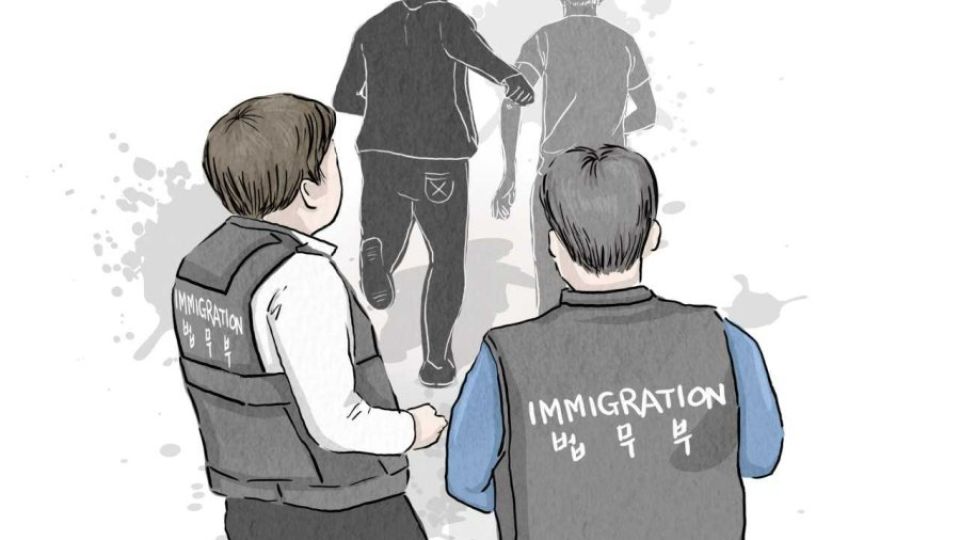March 27, 2023
SEOUL – The names of immigration service field officials interviewed by The Korea Herald are aliases to protect their identities. — Ed.
Kim Jong-sup, who works at a local branch office of the Korea Immigration Service, never thought he would be risking his life in the course of his job.
“Yesterday, I went to detain illegal aliens working at a water parsley farm. I (fell and) rolled over and suffered bruises all over my body,” Kim said, showing his broken glasses.
It was not the first time that Kim had met resistance during crackdowns, and a lack of numbers leaves officers like him relatively exposed. Workers have occasionally resisted using improvised weapons such as bats and saws.
Kim, who is in his 30s, carries no weapons himself, only handcuffs. Immigration officials are allowed to carry and use weapons provided by the KIS, such as pistols and stun guns, but Kim said that most officers chose not to, based on advice from the National Human Rights Commission of Korea.
Rather than weapons, most officers indicated that safety could be improved with more manpower — particularly physically strong workers with self-defense training.
Reports of people working illegally in Korea keep coming into his office, but Kim feels uneasy whenever he goes out to verify them — a field job very different from his previous role as an airport security official.
“My life has been in danger many times, but I have not been seriously injured or killed,” the official said.
His colleague, Lee Sung-tae, said that some immigration officers have died during crackdowns.
“There have been public officials who have died in the past while conducting crackdowns, so I am worried about my safety whenever I go out for one,” Lee said.
“I also had a physical fight with an illegal migrant who resisted our crackdown at an onion farm the day before yesterday, and all of my clothes were ripped. My bare skin was exposed,” he said.
“Once, an illegal migrant swung a sickle and a furniture-cutting machine at me while running away. Illegal migrants sometimes jump into the roadside or from high floors. Pursuing them in itself is dangerous.”
The KIS, under the Ministry of Justice, oversees immigration affairs, including border security, visa management, naturalization, and enforcing immigration regulations. It operates 12 local branch offices as well as central offices in the major cities of Seoul, Busan, Incheon and Jeju.
Many foreign workers who are in Korea illegally enter the country through a temporary work permit system, but stay after their visas have expired, according to Kim and Lee. Most of them find another place to work before running away from the businesses that initially hired them as temporary workers. They usually choose to work illegally because they can make more money at these jobs than at those they are legally permitted to work in. There are also many others who enter the country on tourist visas or via fishing boats without work permits.
If they are caught and deported from Korea to their home countries, they are banned from re-entry. However, it’s difficult to earn an equivalent amount of money that they would earn here — usually 3 million to 4 million won per month ($2,300-$3,000) — once they return to their home countries, the KIS officials said, so they resist as much as possible.
In addition, most of the jobs they do are ones that Koreans are reluctant to do, as many of the worksites have lax safety standards.
In August 2014, an official at the Incheon Immigration Office was part of a crackdown at a factory where 30 workers from Vietnam were illegally employed. When the official stepped on a faulty floor panel on an upper floor, he fell and died.
Lack of resources for crackdowns, safety
Before the COVID-19 pandemic, each immigration office used to catch 3,000 to 4,000 people a year who were in Korea illegally. However, the number significantly decreased during the pandemic as the border was closed, according to Kim and Lee.
According to the Justice Ministry, about 410,000 foreign nationals are in Korea illegally. With air carriers resuming international flights, the ministry plans to increase enforcement to pre-COVID-19 levels. There are also plans to establish a new agency for overseeing immigration this year, the targets for which include a push to reduce the number of migrants who are here illegally to 200,000 by 2027.
But Kim and Lee say they don‘t have enough human resources to deal with the increased numbers. Their team of five is assigned to deal with thousands of people in the region who are in Korea illegally.
Foreign nationals awaiting deportation are currently forcibly detained in what are called “protection rooms” located within immigration offices, before their flights are ready and other paperwork is complete.
“It is also necessary to expand immigration offices and the protection rooms inside them to ensure the safety of illegal immigrants who have been caught,” Lee said.
The fact that there are many foreign nationals who are illegally working in Korea is not actually a big problem, according to Yoon In-jin, a sociology professor at Korea University and the president of the Korean International Migration Studies Association. However, the government shouldn’t give an impression that there is no state control, he said, adding that there should be better management of these workers for their own safety.
“They are exposed to dangers as well. Even if they are hurt at work or elsewhere, it is not easy for them to receive proper treatment or compensation,” Yoon said.
Meanwhile, migrants’ rights groups in Korea say the immigration service’s tracking down and deporting of undocumented workers constitute serious human rights abuse.
Members from migrants’ rights groups such as the Nancen Refugee Rights Center, Migrant Human Rights Solidarity Corporation and Migrants Center Friend have urged the government to stop the crackdowns, arguing that the government should give undocumented workers a chance to become legal residents in Korea.


